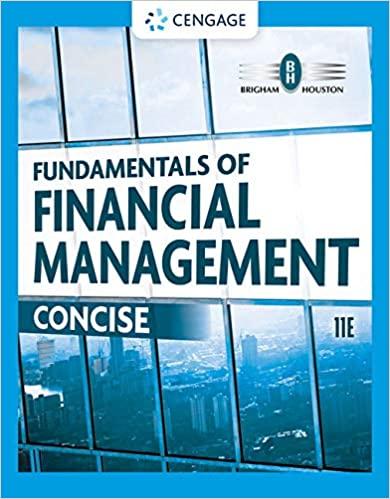Question
I need help with this project -- please contact me for further explanation CARRY OUT ALL CALCULATIONS IN EXCEL! You will be penalized if not
I need help with this project -- please contact me for further explanation
CARRY OUT ALL CALCULATIONS IN EXCEL! You will be penalized if not all calculations are done with Excel formulas.
DO NOT COOPERATE WITH OTHER STUDENTS! This is an individual assignment.
You are advising an investor, who is interested in purchasing a multi-tenant office building in Fort Lauderdale, which has an asking price of $120 per SF. Assume that, apart from 2% purchasing costs, there are no additional acquisition-related costs. Purchasing costs cannot be rolled into a mortgage and have to be paid out of pocket. The building size is 60,390 SF. It is currently leased to three tenants:
The first tenant is currently renting 24,156 SF for $24.5/SF/year. The lease will expire in 2 years (end of year).
The second tenant is currently renting 10,266 SF for $23/SF/year. The lease will expire in 4 years (end of year) and has an annual rent increase of 2.5%.
The third tenant is currently occupying the remaining space for $22/SF/year and the lease will expire in 6 years (end of year). Rental increases of $2 per SF will occur at the beginning of the 2nd and 4th year.
After the first lease expires, assume a V&C of 5% of the PGI each year, which will increase to 10% once the second lease expires. The market rent is currently $19.25/SF/year and is expected to decrease by 3% each year for the next 3 years and then increase again by 2.5% each year for the next 4 years.
Operating expenses for all leases are currently $9/SF/year and will increase annually by 2.5% (i.e. with inflation). The landlord covers 30% of operating expenses. No non-operating expenses occur. A capital expense reserve of $2 per SF is created for each year. At the point of sale, this reserve is eliminated and represents a cash inflow.
The building is depreciated over 39 years (mid-year convention for first and last year apply) and the value of improvements (building) is considered to be 80% of the purchasing price. The going out cap rate is 9% and the investor requires a return of 10%. Selling costs are 2% of the sales price. The investor expects to hold the building for 5 years. Assume an income tax of 35% and a capital gains tax of 15%. For simplicity, you can use the capital gains tax rate for depreciation recapture and pure capital gain at the time of sale.
Part 1: Assuming that the investor wants to hold the property for 5 years, conduct a discounted cash flow analysis (DCF) to calculate the after-tax IRR and NPV for this investment. The investor received a lender's offer for a 30year mortgage at 8% (compounded monthly) with a loan to value ratio (LTV) of 75%. No financing costs (e.g. origination fees) or discount points occur. Considering this FRM, what is the after-tax NPV and IRR? Is this investment worth undertaking?
Part 2: The investor also has received offers for adjustable rate mortgages by three lenders. All have annual interest rate adjustments. All mortgages assume a LTV of 70% and 30 years maturity. For simplicity, use annual compounding.
ARM I
ARM II
ARM III
Initial interest
5%
3/1 mortgage; initial interest is fixed for 3 years and only interest is paid. Amortization begins in year 4.
6.5%
5.5%
Margin
2%
2.5%
2%
Caps
None
Periodic interest cap: 1.5% (no negative amortization)
Periodic interest floor: 2%
Periodic payment cap of 4.5% (no negative amortization)
Prepayment penalty
None
3%
3%
Discount Points
2%
None
2%
Interest rates are expected to change as follows over the next 5 years:
Year
2
3
4
5
Index
3%
2.25%
1.75%
2.5%
Calculate the payments for all three mortgages, i.e. calculate the initial cash inflow from the mortgage, the annual payments and ending balance after 5 years.
Calculate the interest rate you are effectively paying for each of the three mortgages. Which mortgage has the lowest effective rate?
Redo the investment analysis with the ARM you chose as having the lowest effect rate. What is the after-tax IRR and NPV for this mortgage option? Is this investment still worth undertaking? Should the investor choose the FRM or ARM?
Part 3: The investor is also approached by a lender, who is interested in providing a 30yr FRM with a 4.5% interest rate (monthly compounding) and LTV of 85%. However, the lender requires a share of 60 % in the before tax equity reversion (BTER).What is the after-tax IRR and NPV? Is this investment still worth undertaking?
Part 4: Overall and considering the FRM, ARM and SAM, which option would you recommend the investor and why? (You can answer this in an easy-to-find space in your Excel file.)
Step by Step Solution
There are 3 Steps involved in it
Step: 1

Get Instant Access to Expert-Tailored Solutions
See step-by-step solutions with expert insights and AI powered tools for academic success
Step: 2

Step: 3

Ace Your Homework with AI
Get the answers you need in no time with our AI-driven, step-by-step assistance
Get Started


